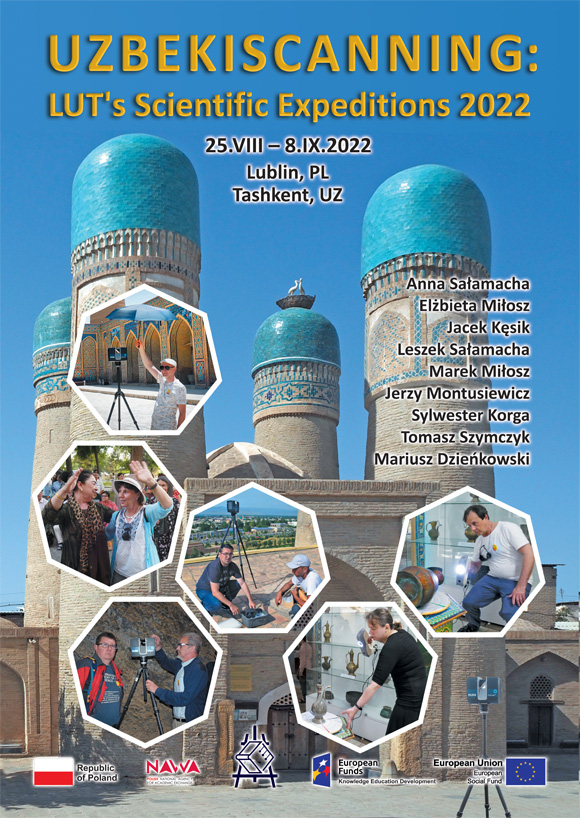We would like to invite you to see the Uzbekiscanning: LUT’s Scientific Expeditions 2022 Exhibition in the Gallery of the Centre of Scientific and Technical Information. The exhibition will be open until the 8th September 2022.

The current photo exhibition is a collective work of all participants of the last two Scientific Expeditions of the Lublin University of Technology to Central Asia, operating in the territory of today's Uzbekistan. The first of them, to Samarkand, took place on May 5-18, 2022, and its participants were: Elżbieta Miłosz, Marek Miłosz, Jerzy Montusiewicz, Anna Sałamacha, Sylweter Korga and Tomasz Szymczyk. The second, much shorter expedition took place on June 5-12, 2022, and led the participants to Bukhara (Elżbieta Miłosz, Marek Miłosz, Jerzy Montusiewicz, Jacek Kęsik, Mariusz Dzieńkowski and Leszek Sałamacha). Counting from the beginning of the cooperation between the employees of the Department of Computer Science of the Lublin University of Technology (2015) with universities and museums in Central Asia, these were the 7th and 8th expeditions, respectively, the purpose of which was primarily to scan cultural heritage objects of those regions in various 3D technologies.
The cooperation has been interdisciplinary from the very beginning, which means that both parties bring to it knowledge and skills that are unique. This situation has built mutual respect between the partners and, through the generated synergy, has allowed for exceptional results that can be viewed and studied on the silkroad3d.com portal.
One must not forget about the basic fact: without organising access to cultural goods, on site in Uzbekistan, to museum artefacts, to interiors inaccessible to the average tourist, it would not be possible to carry out 3D scanning of its. We owe it all to our partners from the Silk Road. It was they who arranged for us the appropriate "entrances": Dilbar Mukhamedova from the National University of Uzbekistan, Rahim Kayumov from Samarkand State University, Bakhodir Eschanov from Chirchik State Pedagogical Institute of the Tashkent region, Utkir Abdullaev from Urgench State University and others. Their personal contacts, as well as the support of museum directors, opened to us access to historic buildings in Uzbekistan.
Working in the field in local conditions is not easy, on the contrary it requires good health, persistence in action and creativity in solving emerging problems. Scanning outdoors for many hours, when the temperature reaches 42oC in the shade, when specialised equipment, heated to a temperature of 60oC, refuses to operate, when an overheated tablet slows down numerical processes so much that it is unable to download data sent by the scanner implies, not for the first time, that the equipment was not designed for such conditions. We tried various solutions that allowed us to partially solve these problems: shielding the scanner from sunlight with a black umbrella (hence such photos), replacing the batteries and cooling the overheated ones in the air stream of air conditioners, placing the working tablet within the range of cold air, as well as scanning museum artefacts outside that stream so as not to catch a cold or carrying out the scanning process in rooms with air conditioning. These and other solutions allowed successful performance of relevant works. In total, we have brought over 250 GB of raw data. We performed 3D scanning of over 45 small museum artefacts and 15 large architectural objects.
The photos show the participants of the expedition and the people supporting us in 3D digitisation. They helped us to set up the equipment, move museum objects, scan them when we climbed normally inaccessible roofs and terraces to get the right venues for setting up the laser scanner. In addition, the photos try to show the oriental atmosphere of those cities: first of all, the people we met, in their characteristic costumes, in various life situations: joyful, focused, praying and dancing. The world of Uzbekistan, despite the presence of steppes and deserts, is a space full of colours, which can be easily seen in bazaars, exhibitions and light shows. There are a few pictures of the culinary that have been given a common title – the flavours of Uzbekistan. They show three main dishes: plov – a dish consisting of rice, meat, vegetables (yellow carrot and onion), dried raisins and kaza (horse sausage), lagman – pasta, meat, tomatoes, pepper (served as a thick soup) and lepioshka – bread in the form of flat cakes, which is not cut with a knife, but divided by hand and given to all the guests.
Exhibition curator
Jerzy Montusiewicz

Projekt współfinansowany ze środków Unii Europejskiej w ramach Europejskiego Funduszu Społecznego, Program Operacyjny Wiedza Edukacja Rozwój 2014-2020 "NAZWA PROGRAMU" POWR.00.00.00-00-z000/00-00 Unia Europejska jest super! :-)
The websites of Lublin University of Technology use "cookies" in accordance with the privacy policy. Give me more information.